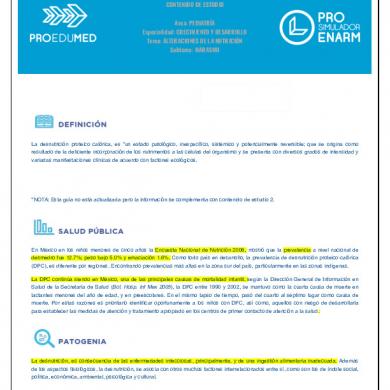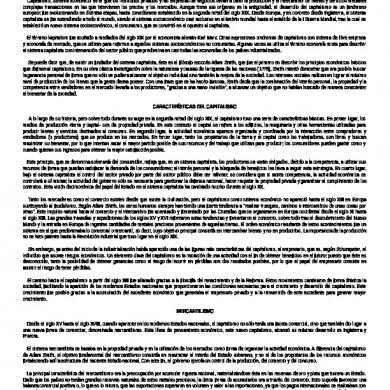Parasitology Recalls Malaria
This document was uploaded by user and they confirmed that they have the permission to share it. If you are author or own the copyright of this book, please report to us by using this DMCA report form. Report DMCA
Overview
Download & View Parasitology Recalls Malaria as PDF for free.
More details
- Words: 703
- Pages:
Loading documents preview...
PARASITOLOGY RECALLS
MALARIA
CASE: Gardo, a 35-year old member of the Philippine Red Cross was admitted at San Lazaro Hospital because of chills, irregular fever, prostration, and profuse sweating for the past two weeks. He claimed to have been with a group of community volunteers and some local health workers in the jungle fringes of Zamboanga Peninsula doing regular medical mission for the past 2 months. On admission, his temperature was 38.5 C and the admitting physician concluded that he has a palpable liver as well. A battery of examinations was performed and the laboratory technologist noticed flagging of the automated hematology analyzer for a possible blood parasite in his blood sample.
107. Gardos’s palpable liver could be due to a. fatty change b. liver cirrhosis c. hypertrophy and hyperplasia of Von Kuppfer cells d. congestion
If the thin blood smear revealed different stages of the parasites and the mature schizont stage contains 6 to 12 chromatin dots arranged like petals of flower, then:
109. The stipplings associated with the parasite in this case is a. zieman’s dots b. schufner’s dots c. christoffer’s bodies d. james’ dots
101. Gardo is suffering from this infection a. Falciparum malaria b. Knowlesi malaria c. Vivax malaria d. Malariae malaria 102. The infection in question #101 has this incubation period a. 2 weeks b. 4 weeks c. 2 months d. 4 months 103. The erythrocytic period is expected to be every a. 72 hours b. 48 hours c. 36-48 hours d. 24 hours
108. The type of fever associated with the infection in this case is a. quotidian fever b. quartan fever c. subtertian fever d. benign tertian fever
110. Expected complications are the following except a. hyperglycemia b. acute lung injury c. GI bleeding d. seizure disorders If fever is noted to be occurring every day and Gardo’s history of exposure to the forest areas of Zamboanga (therefore, think of monkey) is clinically significant in the diagnosis, then 111. Gardo is most likely suffering from a. falciparum infection b. vivax infection c. knowlesi infection d. malariae infection
104. The recurrence of paroxysms after a long dormant period following an acute attack in this infection is called a. relapse b. recrudescence c. reinfection d. autoinfection
112. Period of schizogony is expect to be every a. 24 hours b. 48 hours c. 36-48 hours d. 72 hours
105. An expected kidney pathology associated with this infection could be a. acute tubular necrosis b. immune complex nephritis c. nephrotic syndrome d. A&B only
113. The parasite in this case can be specifically diagnosed by a. thin and thick smear b. serological test c. real time PCR d. IFAT
If the patient eventually develops severe form of malaria with signs and symptoms associated with liver failure..
114. The parasite’s natural reservoir is the a. anopheles mosquito b. long tailed monkey c. human host d. forest
106. The parasite is most likely a. Plasmodium falciparum b. Plasmodium knowelsi c. Plasmodium vivax d. Plasmodium knowlesi ALPHAS MD 2018
Page 1 of 2
PARASITOLOGY RECALLS
MALARIA
Gardo’s manifestations were noted to start with chills followed by fever and excessive sweating. The temperature increase was noted to be recurring every three days (=72 hrs) 115. If your clinical impression is a malaria infection, then Gardo is most likely suffering from a. faciparum malaria b. vivax malaria c. malariae malaria d. knowlesi malaria 116. This parasite has a predilection to a. mature red cells b. reticulocytes c. both mature and young red cells d. thrombocytes 117. What is the infective stage of the parasite in question to the intermediate host a. gametocyte b. schizont c. merozoites d. sporozoites 118. Morphologically, the parasite is associated with the following EXCEPT a. band forms b. hemozoin pigments c. enlarged infected red cells d. stipplings 119. The DOC for this infection is a. Chloroquine b. Primaquine c. ACT d. Doxycycline 120. In the life cycle of the parasite in question a. the parasites in the liver may develop into hypnozoites b. sporozoites are the pathogenic stages of the parasite c. exflagellation develops during the schizogonic phase of the life cycle d. gametocytes are products of the sporogonic phase of the life cycle
ALPHAS MD 2018
Page 2 of 2
MALARIA
CASE: Gardo, a 35-year old member of the Philippine Red Cross was admitted at San Lazaro Hospital because of chills, irregular fever, prostration, and profuse sweating for the past two weeks. He claimed to have been with a group of community volunteers and some local health workers in the jungle fringes of Zamboanga Peninsula doing regular medical mission for the past 2 months. On admission, his temperature was 38.5 C and the admitting physician concluded that he has a palpable liver as well. A battery of examinations was performed and the laboratory technologist noticed flagging of the automated hematology analyzer for a possible blood parasite in his blood sample.
107. Gardos’s palpable liver could be due to a. fatty change b. liver cirrhosis c. hypertrophy and hyperplasia of Von Kuppfer cells d. congestion
If the thin blood smear revealed different stages of the parasites and the mature schizont stage contains 6 to 12 chromatin dots arranged like petals of flower, then:
109. The stipplings associated with the parasite in this case is a. zieman’s dots b. schufner’s dots c. christoffer’s bodies d. james’ dots
101. Gardo is suffering from this infection a. Falciparum malaria b. Knowlesi malaria c. Vivax malaria d. Malariae malaria 102. The infection in question #101 has this incubation period a. 2 weeks b. 4 weeks c. 2 months d. 4 months 103. The erythrocytic period is expected to be every a. 72 hours b. 48 hours c. 36-48 hours d. 24 hours
108. The type of fever associated with the infection in this case is a. quotidian fever b. quartan fever c. subtertian fever d. benign tertian fever
110. Expected complications are the following except a. hyperglycemia b. acute lung injury c. GI bleeding d. seizure disorders If fever is noted to be occurring every day and Gardo’s history of exposure to the forest areas of Zamboanga (therefore, think of monkey) is clinically significant in the diagnosis, then 111. Gardo is most likely suffering from a. falciparum infection b. vivax infection c. knowlesi infection d. malariae infection
104. The recurrence of paroxysms after a long dormant period following an acute attack in this infection is called a. relapse b. recrudescence c. reinfection d. autoinfection
112. Period of schizogony is expect to be every a. 24 hours b. 48 hours c. 36-48 hours d. 72 hours
105. An expected kidney pathology associated with this infection could be a. acute tubular necrosis b. immune complex nephritis c. nephrotic syndrome d. A&B only
113. The parasite in this case can be specifically diagnosed by a. thin and thick smear b. serological test c. real time PCR d. IFAT
If the patient eventually develops severe form of malaria with signs and symptoms associated with liver failure..
114. The parasite’s natural reservoir is the a. anopheles mosquito b. long tailed monkey c. human host d. forest
106. The parasite is most likely a. Plasmodium falciparum b. Plasmodium knowelsi c. Plasmodium vivax d. Plasmodium knowlesi ALPHAS MD 2018
Page 1 of 2
PARASITOLOGY RECALLS
MALARIA
Gardo’s manifestations were noted to start with chills followed by fever and excessive sweating. The temperature increase was noted to be recurring every three days (=72 hrs) 115. If your clinical impression is a malaria infection, then Gardo is most likely suffering from a. faciparum malaria b. vivax malaria c. malariae malaria d. knowlesi malaria 116. This parasite has a predilection to a. mature red cells b. reticulocytes c. both mature and young red cells d. thrombocytes 117. What is the infective stage of the parasite in question to the intermediate host a. gametocyte b. schizont c. merozoites d. sporozoites 118. Morphologically, the parasite is associated with the following EXCEPT a. band forms b. hemozoin pigments c. enlarged infected red cells d. stipplings 119. The DOC for this infection is a. Chloroquine b. Primaquine c. ACT d. Doxycycline 120. In the life cycle of the parasite in question a. the parasites in the liver may develop into hypnozoites b. sporozoites are the pathogenic stages of the parasite c. exflagellation develops during the schizogonic phase of the life cycle d. gametocytes are products of the sporogonic phase of the life cycle
ALPHAS MD 2018
Page 2 of 2
Related Documents

Parasitology Recalls Malaria
January 2021 1
Parasitology
February 2021 1
Dsk-malaria
January 2021 1
Parasitology Table
February 2021 1
Malaria Knowlesi
January 2021 1
Recalls September 2018
January 2021 1More Documents from "Tom Knob"

Parasitology Recalls Malaria
January 2021 1
!!!elaw2010_guidebook For Evaluating Mining Project Eias
January 2021 1


